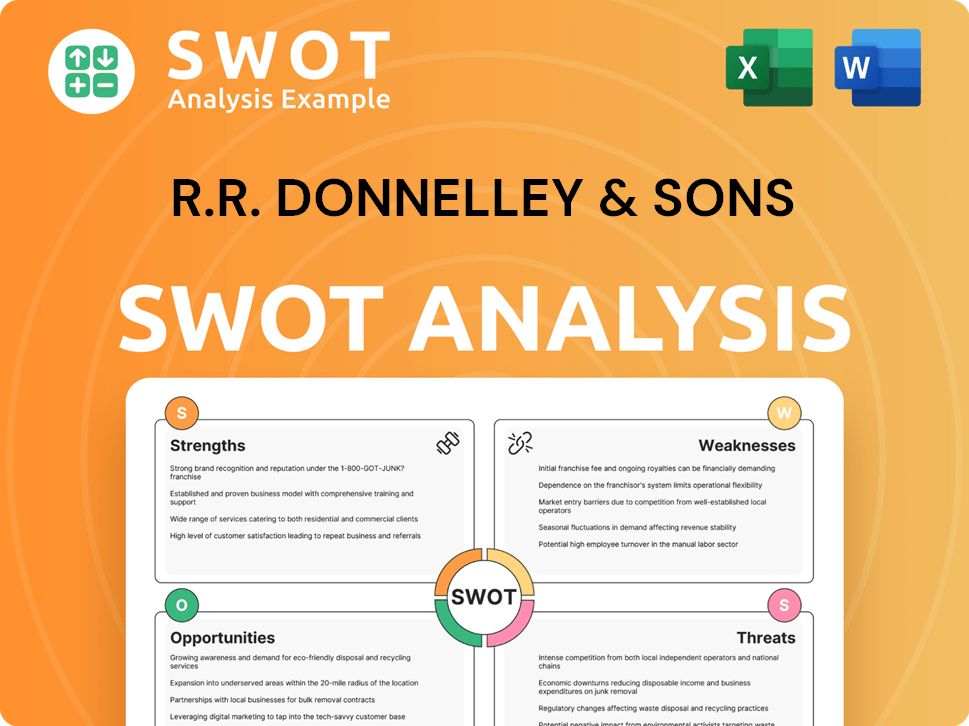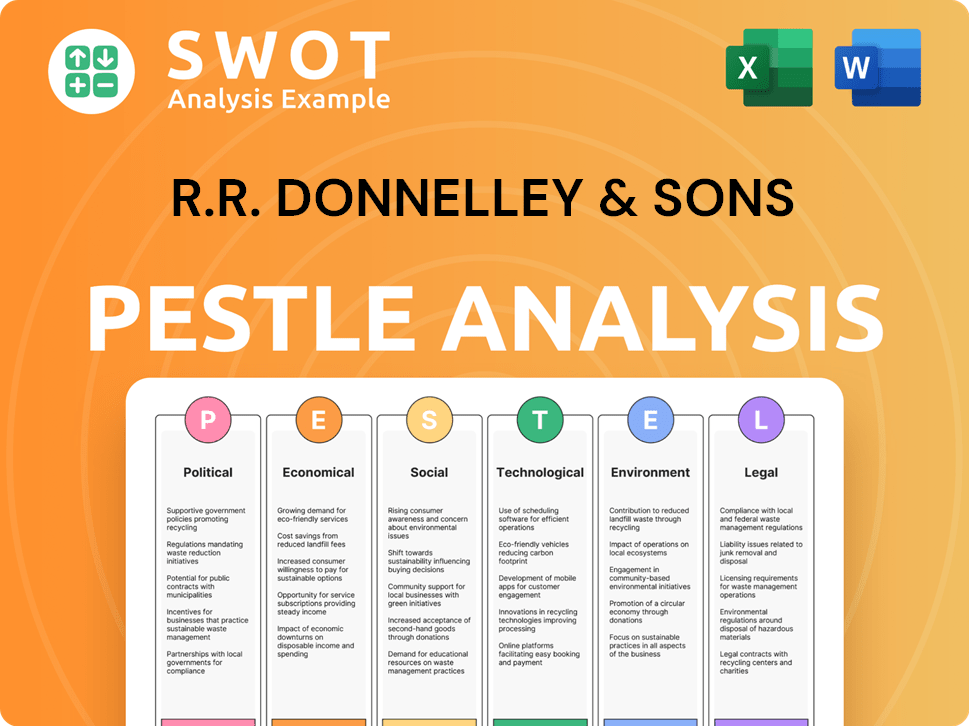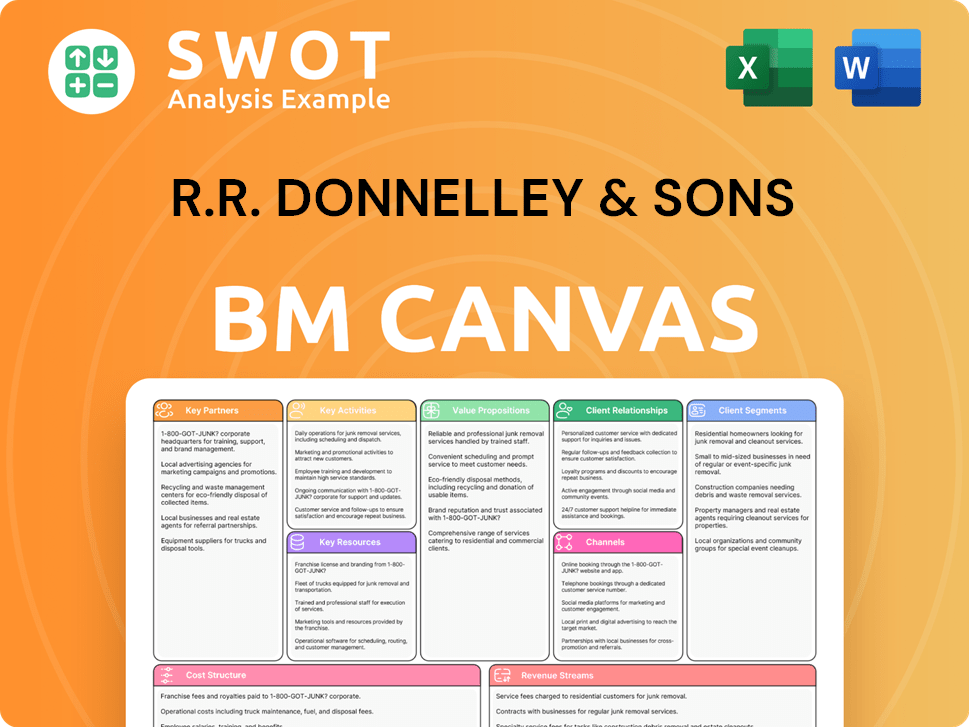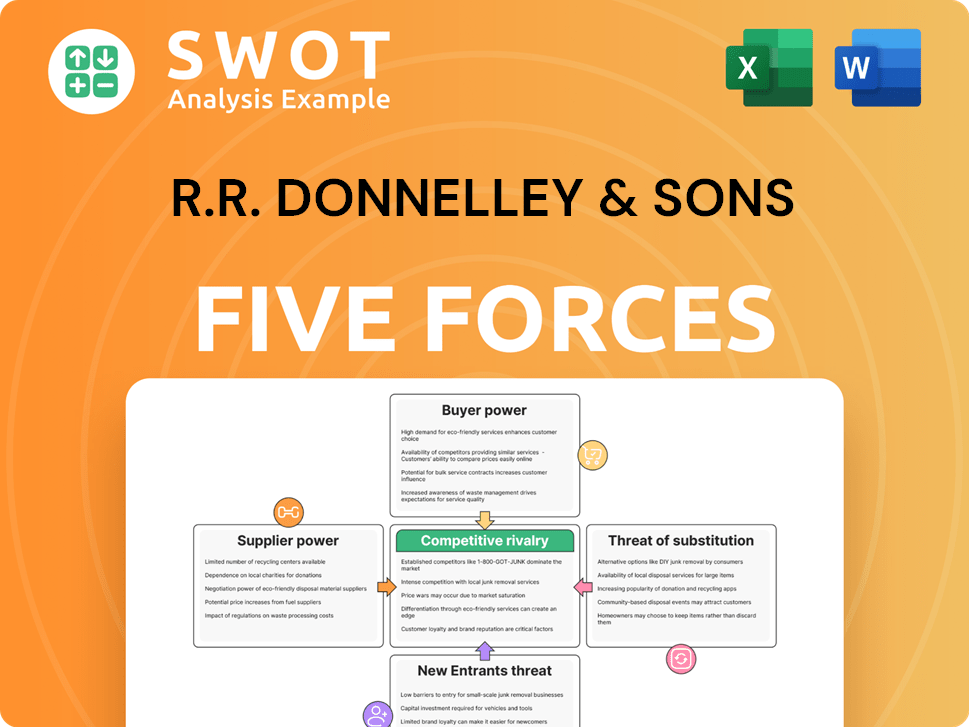R.R. Donnelley & Sons Bundle
How is R.R. Donnelley & Sons Company Navigating the Modern Market?
From its roots in 1864 Chicago, R.R. Donnelley & Sons (RRD) has undergone a dramatic transformation. The company's strategic pivot into digital solutions, highlighted by the recent acquisition of Williams Lea in January 2025, signals a bold move in the evolving business landscape. This article explores the R.R. Donnelley & Sons SWOT Analysis, sales, and marketing strategies driving this evolution.

This shift is crucial, considering the decline in the commercial printing market and the surge in digital advertising. We'll dissect RRD's modern sales channels, marketing tactics, and brand positioning to understand how they're adapting. Learn about key campaigns and initiatives that showcase RRD's approach to customer relationships and market positioning, providing insights into their sales process and overall RRD business strategy.
How Does R.R. Donnelley & Sons Reach Its Customers?
The sales and marketing strategy of R.R. Donnelley & Sons Company (RRD) hinges on a multifaceted approach, integrating both traditional and digital channels to reach its diverse clientele. This strategy reflects a strategic shift from a print-centric model to an integrated print and digital approach. RRD's commitment to this integration is further evidenced by its investments in advanced printing technologies and marketing automation tools.
RRD's primary sales channels include direct sales teams, which likely handle complex enterprise accounts and customized solutions, and a growing emphasis on digital platforms. This evolution is crucial, especially as digital marketing spending is projected to reach $270 billion in 2024. The company's focus on digital transformation, including advanced printing technologies and marketing automation tools, indicates a strong move towards online engagement and e-commerce capabilities.
Key partnerships and acquisitions have significantly contributed to RRD's growth and market share. The acquisition of digital and print marketing businesses from Vericast Corp. in July 2024 expanded RRD's digital marketing capabilities. Furthermore, the acquisition of Williams Lea, finalized in January 2025, significantly enhanced RRD's tech-enabled business services and digital marketing solutions, positioning it as a market leader in tech-enabled business support within regulated industries. For a broader understanding, you can explore the Competitors Landscape of R.R. Donnelley & Sons.
RRD utilizes direct sales teams to manage complex enterprise accounts and provide customized solutions. These teams likely focus on building and maintaining strong client relationships. This approach allows for personalized service and tailored marketing strategies.
RRD is heavily investing in digital platforms, including advanced printing technologies and marketing automation tools. This shift towards digital channels is crucial for engaging with customers online. The focus is on e-commerce capabilities and digital marketing.
Acquisitions like Vericast Corp. and Williams Lea have expanded RRD's capabilities. These moves have strengthened its digital marketing offerings, including display advertising, contextual targeting, and email marketing. These partnerships are key to enhancing the company's market position.
RRD is integrating print and digital channels, with 91% of marketers embracing this approach in 2024. This integrated strategy allows for a more comprehensive and coordinated marketing effort. RRD is installing new presses to improve productivity and flexibility.
RRD's investments and acquisitions are pivotal to its sales and marketing strategy. These strategic moves enhance its capabilities and market reach. The company is adapting to the changing marketing landscape.
- Acquisition of digital and print marketing businesses from Vericast Corp. in July 2024 expanded RRD's digital marketing capabilities.
- The acquisition of Williams Lea, finalized in January 2025, enhanced RRD's tech-enabled business services.
- RRD plans to install over fifteen new HP Indigo and PageWide Presses across facilities.
- Digital marketing spending is projected to reach $270 billion in 2024.
R.R. Donnelley & Sons SWOT Analysis
- Complete SWOT Breakdown
- Fully Customizable
- Editable in Excel & Word
- Professional Formatting
- Investor-Ready Format

What Marketing Tactics Does R.R. Donnelley & Sons Use?
The company employs a multifaceted R.R. Donnelley marketing strategy, integrating digital and traditional marketing tactics to boost brand awareness, generate leads, and drive sales. This approach includes a blend of digital strategies like content marketing and SEO, alongside traditional methods such as direct mail. The focus is on creating a cohesive customer experience across various touchpoints.
Digital marketing efforts are enhanced by technology integration, including data analytics and marketing automation. Traditional marketing, particularly direct mail, remains a significant component of the Donnelley marketing strategy, often used to complement digital campaigns. This strategy is supported by data-driven approaches, customer segmentation, and personalization to improve customer interactions.
A key component of the RRD business strategy involves data-driven marketing, customer segmentation, and personalization. The company uses advanced analytics and real-time dashboards to design and deliver tailored communications. This strategy aims to improve customer experiences across various interactions, backed by investments in personalized marketing.
The company uses a range of digital marketing tactics. These include content marketing, SEO, paid advertising, email marketing, and social media. Technology integration, such as data analytics and marketing automation, is also a key part of the strategy.
A 2024 study showed that 91% of marketers with print marketing programs are integrating print and digital channels. They use AI, QR codes, and web-to-print technologies to bridge experiences. 31% of marketers plan to use AI to support print marketing efforts.
Direct mail is still a significant part of the marketing strategy. It reinforces messaging and drives traffic to online channels. The direct mail industry is projected to reach $73.57 billion by 2026.
The company uses data-driven marketing, customer segmentation, and personalization. In Q1 2024, 68% of marketers used customer data to personalize print campaigns. Revenue from data-driven solutions grew by 12% in Q1 2024.
The company emphasizes personalized value and authenticity. A 2024 study indicated that 75% of marketers plan to increase investment in personalized marketing. 30% of marketers focus on personalized offers.
75% of marketers are reallocating marketing budgets to direct mail, recognizing its ability to cut through digital clutter. 82% of marketers increased their direct mail spending in 2024.
The company's R.R. Donnelley sales strategy involves a mix of digital and traditional marketing. Key tactics include content marketing, SEO, paid advertising, and direct mail. The focus is on data-driven personalization and integrating print and digital channels.
- Digital Marketing: Content marketing, SEO, paid advertising, email marketing, and social media are used.
- Print Marketing: Direct mail is used to complement digital efforts and drive online traffic.
- Data Analytics: Data-driven approaches are used for customer segmentation and personalization.
- Technology Integration: AI, QR codes, and web-to-print technologies are used to enhance customer experiences.
- Personalization: Personalized offers and targeted communications are emphasized.
R.R. Donnelley & Sons PESTLE Analysis
- Covers All 6 PESTLE Categories
- No Research Needed – Save Hours of Work
- Built by Experts, Trusted by Consultants
- Instant Download, Ready to Use
- 100% Editable, Fully Customizable

How Is R.R. Donnelley & Sons Positioned in the Market?
RRD positions itself as a global provider of marketing, packaging, print, and supply chain solutions. The company aims to elevate engagement across the complete customer journey. This approach is central to its R.R. Donnelley sales strategy and overall R.R. Donnelley strategy.
The brand differentiates itself through a comprehensive portfolio, including creative execution, worldwide business process consulting, and services designed to lower environmental impact. With a client base of 18,000, including 92% of the Fortune 100, RRD emphasizes its expertise, execution, and scale in transforming customer touchpoints.
The core message revolves around delivering end-to-end solutions to help organizations create, manage, deliver, and optimize marketing and business communications across various channels. RRD's Donnelley marketing strategy focuses on a client-centric approach, tailoring solutions to diverse industries such as healthcare, financial services, retail, and publishing.
RRD's client-centric approach tailors solutions to meet specific needs, differentiating it in a competitive market. This personalized approach is key to their Donnelley sales efforts. This strategy helps RRD effectively target its diverse customer base.
Sustainability is a key aspect of RRD's brand positioning, appealing to environmentally conscious clients. The company emphasizes eco-friendly materials, energy-efficient processes, and waste reduction. RRD's 2024 Packaging & Labels Insight Report indicates that 57% of packaging respondents plan to adopt sustainable and eco-friendly aesthetic directions in the next two years.
Brand consistency is maintained through integrated solutions that blend physical and digital channels. This approach aims to streamline marketing for clients and deliver measurable outcomes. RRD's investments in advanced printing technologies and data analytics further enhance its offerings.
RRD is committed to reducing its environmental impact. The company has made significant progress toward its global 10-year 25% greenhouse gas (GHG) emissions reduction goal. In 2023, RRD achieved a reduction of over 12.5% compared to its 2022 baseline. For more details, see the Growth Strategy of R.R. Donnelley & Sons.
RRD's market positioning strategy is built on several key differentiators. These elements contribute to its competitive advantage in marketing.
- Comprehensive Solutions: Offering end-to-end services across marketing, packaging, print, and supply chain.
- Client-Centric Approach: Tailoring solutions to meet the specific needs of diverse industries.
- Sustainability Focus: Emphasizing eco-friendly practices and environmental responsibility.
- Technological Innovation: Investing in advanced printing technologies, data analytics, and marketing automation.
R.R. Donnelley & Sons Business Model Canvas
- Complete 9-Block Business Model Canvas
- Effortlessly Communicate Your Business Strategy
- Investor-Ready BMC Format
- 100% Editable and Customizable
- Clear and Structured Layout

What Are R.R. Donnelley & Sons’s Most Notable Campaigns?
The sales and marketing strategy of R.R. Donnelley & Sons (RRD) in 2024 and 2025 centers on integrated marketing solutions and data-driven personalization. The company focuses on helping clients leverage both print and digital channels effectively. This approach is designed to enhance customer engagement and drive measurable results.
RRD's marketing efforts in 2024 have strategically integrated print and digital channels to create a cohesive customer experience. The campaigns aim to showcase the synergy between print and digital. This is achieved through direct mail with QR codes and web-to-print technologies, complemented by digital marketing initiatives that include AI for personalized print campaigns. These efforts are supported by the company's investment in variable data printing, projected to reach $6.5 billion by 2025.
Another key aspect of RRD's strategy involves data-driven personalization, with a focus on tailored messaging based on customer data. This strategy uses variable data printing to customize marketing materials, enhancing customer engagement and potentially increasing response rates. The company's emphasis on sustainability and e-commerce growth in packaging and labels is another critical area.
RRD's R.R. Donnelley sales strategy involves integrating print and digital channels. The Print Impact Report indicates that 91% of marketers are embracing this integration. This approach uses direct mail with QR codes and web-to-print technologies.
A key component of the Donnelley marketing strategy is data-driven personalization. 68% of marketers use customer data for personalized print campaigns. This strategy aims to enhance customer engagement and response rates.
RRD is emphasizing sustainability and e-commerce growth in packaging and labels. With 78% of packaging respondents and 79% of label respondents reporting a rise in e-commerce business, RRD is focusing on solutions for product protection and customer satisfaction.
RRD's achievements include being named Mail Service Provider of the Year at the 2025 National Postal Forum. RRD Asia was honored as the Distinguished Company at the Asia Pacific Business Awards 2024-2025. These awards highlight the success of the company's campaigns.
These campaigns reflect RRD's commitment to innovation and customer-centric solutions. For a deeper understanding of the company's background, you can explore the Brief History of R.R. Donnelley & Sons.
R.R. Donnelley & Sons Porter's Five Forces Analysis
- Covers All 5 Competitive Forces in Detail
- Structured for Consultants, Students, and Founders
- 100% Editable in Microsoft Word & Excel
- Instant Digital Download – Use Immediately
- Compatible with Mac & PC – Fully Unlocked

Related Blogs
- What are Mission Vision & Core Values of R.R. Donnelley & Sons Company?
- What is Competitive Landscape of R.R. Donnelley & Sons Company?
- What is Growth Strategy and Future Prospects of R.R. Donnelley & Sons Company?
- How Does R.R. Donnelley & Sons Company Work?
- What is Brief History of R.R. Donnelley & Sons Company?
- Who Owns R.R. Donnelley & Sons Company?
- What is Customer Demographics and Target Market of R.R. Donnelley & Sons Company?
Disclaimer
All information, articles, and product details provided on this website are for general informational and educational purposes only. We do not claim any ownership over, nor do we intend to infringe upon, any trademarks, copyrights, logos, brand names, or other intellectual property mentioned or depicted on this site. Such intellectual property remains the property of its respective owners, and any references here are made solely for identification or informational purposes, without implying any affiliation, endorsement, or partnership.
We make no representations or warranties, express or implied, regarding the accuracy, completeness, or suitability of any content or products presented. Nothing on this website should be construed as legal, tax, investment, financial, medical, or other professional advice. In addition, no part of this site—including articles or product references—constitutes a solicitation, recommendation, endorsement, advertisement, or offer to buy or sell any securities, franchises, or other financial instruments, particularly in jurisdictions where such activity would be unlawful.
All content is of a general nature and may not address the specific circumstances of any individual or entity. It is not a substitute for professional advice or services. Any actions you take based on the information provided here are strictly at your own risk. You accept full responsibility for any decisions or outcomes arising from your use of this website and agree to release us from any liability in connection with your use of, or reliance upon, the content or products found herein.